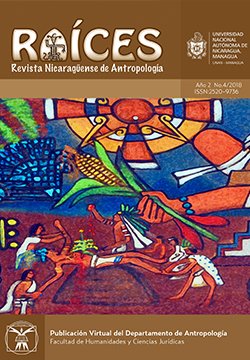El Realejo: a living community on a site Historical Archeology
DOI:
https://doi.org/10.5377/raices.v2i4.7816Keywords:
Cultural Anthropology, Archeology, Cultural Heritage, Sustainable TourismAbstract
He sociocultural anthropology of the community of El Realejo, municipality of the Department of Chinandega is a topic of great importance that needs to be analyzed; it is a population located on the archeohistorical vestiges of what was the first geographical colonial space of Nicaragua. The conqueror Andrés Niño baptized it as Port of Possession in 1522 and formally annexed it to the properties of the Spanish Crown, as part of the Western invading policies, years later it was called Puerto de la Posesión de El Realejo by the foundation of La Villa de El Realejo in 1534 and hence derives its current name. For a little over three hundred years it was one of the most important colonial ports in Central America. In 2005, we carried out anthropological, archaeological and historical studies in the current population; obtaining interesting data about the colonial location, the living community and the relationship between both through its Material and Intangible Cultural Heritage. The wealth of the municipality can be exploited for the development of Sustainable Community Tourism that
would improve the local economy while protecting, preserving, disseminating and achieving the value of this Cultural Heritage of the Nation Municipality.
Downloads
References
Alemán, H. (25 de Febrero de 2005). La casa de las margaritas. (R. García, Entrevistador)
Áreas, D. L. (2006). Se evidencia, de hecho, que cualquier escenario cultural puede convertir- se en un recurso y producir beneficios, y para ello es necesario establecer me- canismos de interrelación entre el sector público, principalmente gobiernos locales y regionales, el. S/C: S/E.
BCN, B. C. (2017). CARTIGR AFÍA DIGITAL Y CENSO DE EDIFICACIONES CABECERA MUNICIPAL DE ELREALEJO. Managua: web: <http://www.bcn.gob.ni>.Benita. (20 de Febrero de 2005). El Convento san Francisco. (R. G. Vásquez, Entrevistador)
Bolaños, A. V. (1954). Documentos para la historia de Nicaragua, Colección Vega Boaños. Tomo VI. Pag. 121. Managua: Banco de America.
García, R. ( 2010). Investigaciones Arqueohistóricas en León Viejo, Primer Emplazamiento Colonial de Nicaragua
(1524-1610)Patrimonio de la Humanidad. CONTRIBUCIONES REVISTA SAC CIENCIA-ARTE Y CULTUR A, 6-18.
Harris, M. (2006). ANTROPOLOGÍA CULTUR AL. EEUU:S.E.
Meléndez, C. (1976). Hernández de Córdoba, Capitán de conquista de Nicaragua. Managua: Fondo de Promoción Cultural. Banco de America.
Montoya, R. (12 de Marzo de 2016). El Puerto de Icaco. (R. García, Entrevistador)
Newson, L. A. (1986). Indian Survival in Colonial Nicaragua. Oklahoma: Universidad Oklahoma.
Pérez, C. A. (20 de Febrero de 2005). El nombre de la comunidad. (S. Espinoza, Entrevistador)
Sánchez, M. R. (1977). El Corregimiento de El Realejo. En M. R. Sánchez, Historial de El Realejo (pág. 511). Managua: San José.
Sánchez, M. R. (1977). Historial de El Realejo. Managua: San José.
Zuniga, E. (1997). Historia Esclesiastica de Nicaragua. Managua: Unión.




